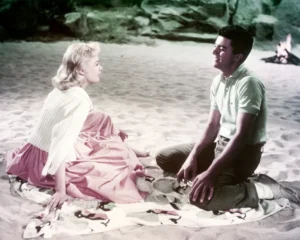
An orphan colt whose mother died shortly after giving birth has a new mom – a mare that had tragically lost her foal – thanks to the generosity of strangers and Washington State University veterinarians playing matchmaker.
Pairing an orphan foal and a nursing mare is a challenging task and one that commonly ends with failure. In this case, the connection was instantaneous.
“The mare had only been without a foal for about 24 hours,” Dr. Lisbeth Matthews, an equine medicine and surgery intern, said. “We walked her into the Veterinary Teaching Hospital and past him. He made a noise, and she went, ‘oh, there’s my foal,’ and started making noises back at him.”
It was a surprise to everyone how quickly the mare, named Shelly but affectionally called Mama by her owners, Roy and Faye Lions, accepted the colt. Equine veterinarian Jenifer Gold, who was helping to care for the foal and to supervise its introduction to the mare, said nursing mares frequently reject orphan foals, and when they don’t, the pairing process often takes days.
“She walked in and started nickering at him like it was her own baby – it was unbelievable,” Gold said. “I’ve been doing this for 20 years, and I have never seen it happen that way.”
The foal, which has been named Laredo, was admitted to the teaching hospital by his owner, Spokane resident Rachel Williams, just days after he was born when he started showing troubling digestive issues. Shortly after the colt arrived in Pullman, Faye Lions placed a call to WSU to see if the equine team was aware of any orphan colts needing a nursing mare.
“Our foal was dead, and nothing was going to bring it back, so we were hoping we could help someone else,” Faye Lions said. “It just so happened there was a foal there.”
A day later, the colt and Shelly were introduced.
“For them to be so willing to basically hand over their animal to a complete stranger after experiencing their own tragedy was pretty phenomenal,” Williams said. “I feel like in this scenario it was the worst of the worst for everybody, but there was a little bit of silver lining to the story.”
Williams is also grateful for the care and treatment she and her foal received at WSU.
“I just can’t even find words to say how great the veterinarians at WSU were,” she said. “They went above and beyond. I am just happy I ended up at WSU. I am so glad we were able to match those two up – it is kind of a miracle.”
Shelly will live with Williams until the colt is ready to be weaned, likely in six months, before she will return to her home in Kamiah, Idaho.
“It will be tough to say goodbye because you just naturally start to bond with animals, and she has kind of been my lifesaver,” Williams said. “It will be bittersweet for sure, but I am sure her owners will be happy to have her back.”
During the spring, the equine team at WSU typically sees at least a handful of orphan foals. Equine medicine specialist Dr. Macarena Sanz said orphan foals can be fed a powdered milk formula designed for horses, but those raised by humans typically develop behavioral issues that can become problematic as the animal matures.
“They turn out to be socially weird, have no understanding of personal space, and they are more difficult to train,” WSU equine veterinarian Macarena Sanz said. “The fact that this orphan foal has a mare is really going to make a difference.”
Sanz strongly encourages owners to immediately call their veterinarian if a foal is orphaned, as early care is critical to the animal’s survival.
TEEN IDOL AND ‘T.J. HOOKER’ LEGEND JAMES DARREN DIES – HOLLYWOOD IN MOURNING

James Darren, the beloved teen idol and star of “T.J. Hooker,” has sadly passed away at the age of 88. His son, Jim Moret, confirmed the unexpected news on Monday, September 2. Details about how Darren died were shared online, providing fans and the public with the unfortunate circumstances surrounding his passing.
James Darren, known for his role as the charming surfer in the classic film “Gidget” alongside the late Sandra Dee, passed away in his sleep at Cedars-Sinai Medical Center in Los Angeles. His son, Jim Moret, shared that the beloved actor died peacefully during his rest.

James Darren’s son, Jim Moret, revealed that his father had been admitted to Cedars-Sinai Medical Center the week before his passing to undergo an aortic valve replacement. Sadly, James was too weak to go through with the procedure.

The day before James Darren passed away, he was rushed back to the hospital. His son, Jim Moret, said that the family was shocked by his sudden death. Jim explained, “It was kind of a surprise to be quite honest with you. I mean, we knew that he was not well, but we didn’t expect this.”

Jim Moret, who is a chief correspondent for “Inside Edition,” shared that in his father’s final moments, James Darren was able to express his love for his family. James, known for his role in “Gidget Goes to Rome” and his influence on the 1960s surfing craze, passed away peacefully without experiencing any pain.
Jim Moret expressed his deep sadness over his father’s passing, saying, “I always thought he would pull through because he was so cool. He was always cool.” These heartfelt words highlight the remarkable legacy James Darren leaves behind as a beloved singer and teen idol.
James Darren’s son, Jim Moret, shared that his father had a special moment with his grandchildren when they saw him perform at the South Point Hotel in 2018. Jim spoke about how meaningful it was for his children to witness James’ talent and share in those artistic experiences.
Jim praised his father’s impressive skills, saying, “He had the swagger, voice, talent, and charm. Their grandfather was cool.” He admired how James Darren’s success extended beyond acting to music, with several hits on Billboard’s Hot 100.
In 1961, James Darren’s song “Goodbye Cruel World” reached number three on the Billboard Hot 100. The following year, his hit “Her Royal Majesty” climbed to number six, and “Conscience” also made the chart, landing at number eleven.
In 1961, James Darren’s song “Goodbye Cruel World” reached number three on the Billboard Hot 100. The following year, his hit “Her Royal Majesty” climbed to number six, and “Conscience” also made the chart, landing at number eleven.
James Darren, known for his success as a singer and actor, also directed popular TV series like “Melrose Place,” “Hunter,” “The A-Team,” and “Beverly Hills, 90210.” He is survived by his sons, Jim, Christian, and Tony Darren, his five grandchildren, and his wife, Evy Norlund.
James Darren, who was also the godfather to Nancy Sinatra’s daughter, A.J. Lambert, received a heartfelt tribute from Nancy Sinatra following his passing. She shared her grief on X, describing James as one of her dearest friends and wishing him a peaceful journey. Nancy also mentioned that it was comforting to know James and other legends are honored together in their hometown.
Our deepest condolences go out to James’ family as they remember an iconic entertainer, loving husband, father, and grandfather.



Leave a Reply